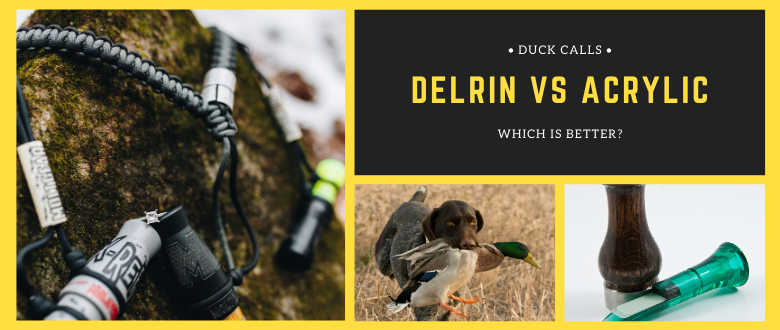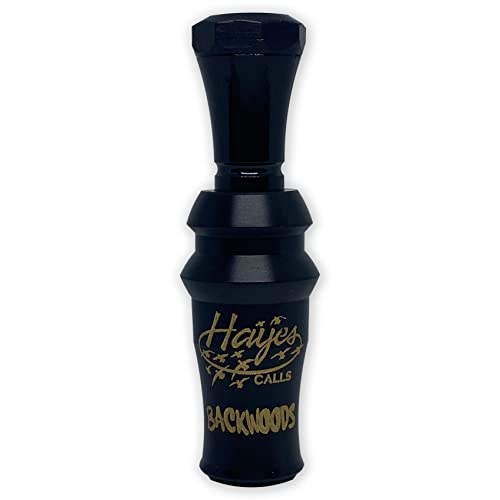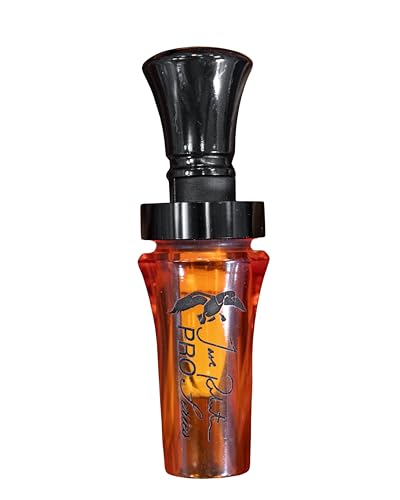↬ Delrin and acrylic are the two most common materials used in the construction of duck calls other than wood. While they both look similar in some respects, there are several conditions where you would want to pick one over the other. The main considerations being a difference in tone and the ease of making your own calls.
Delrin is several times STRONGER and more DURABLE than acrylic! It produces a muffled sound compared to acrylics edginess. Delrin calls are less popular since acrylic is cheaper and easier to mass produce, but the tone of a Delrin call to finish birds up close is unmatched.
In this article, we will explore the differences between Delrin and acrylic in more detail, their properties, advantages, and why they are favored by duck hunters. Additionally, we will compare the two materials and discuss factors to consider when choosing between them.

Delrin vs Acrylic: The Preferred Materials for Duck Calls
Delrin and acrylic are both synthetic materials known for their durability and versatility. They offer distinct advantages when used in the construction of duck calls, providing hunters with reliable and effective calling tools.
However, Delrin is the stronger material. It’s easier to turn when making a call from scratch, although the excess material can wrap around your mandrel. Delrin produces a more muffled sound, and with the right technique can create a coarser sound too.
Acrylic on the other had produces more edge in calling sequences, higher pitches, and it’s just overall louder. Acrylic is the best substitute for wood calls if you need something a little more durable with a similar tone.
What is Delrin?
Delrin, also known as acetal or polyoxymethylene, is a type of engineering thermoplastic. It is prized for its excellent mechanical properties, including high stiffness, low friction, and resistance to moisture and chemicals.
Delrin is commonly used in various industries, from automotive to consumer goods, due to its strength, dimensional stability, and ease of machining. When used in duck calls, Delrin produces muffled and coarse sounds, making it a preferred choice for many hunters. It can also be shaped easier when turned, making it the preferred material for most call makers.
Video from Dupont Youtube Channel showing the durabilty test of Delrin material.
Acrylic Explained
Acrylic, also referred to as Plexiglas or Lucite, is a transparent thermoplastic known for its optical clarity and impact resistance. It is widely used in applications requiring transparency, such as windows, display cases, and lenses.
Acrylic offers excellent durability, weather resistance, and the ability to be easily molded. When used in duck calls, acrylic produces rich and vibrant tones, allowing hunters to effectively mimic a variety of high and low duck sounds. Acrylic is often cheaper than Delrin, which makes it easier to mass produce.
Video from tgbg64 Youtube Channel showing the turning of an acrylic barrel.
Delrin vs Acrylic: Which Should You Choose?
Choosing between Delrin and acrylic for your duck call depends on personal preferences and specific hunting needs. Here are some factors to consider:
Sound Quality: Both Delrin and acrylic can produce high-quality sounds, but they have slightly different tonal characteristics. Delrin tends to produce a muffled sound with coarse undertones, while acrylic offers a sharper and fuller tone. Consider the specific duck species you are targeting and the desired sound profile when making your choice.
Durability: Both materials are known for their durability, but acrylic is generally more resistant to scratches and impacts. If you anticipate rugged hunting conditions or frequent use, acrylic may be a better option to ensure long-lasting performance. The difference in durability between the two for duck hunting though is rarely put to the test.
Aesthetics: Acrylic offers a wide range of vibrant colors and patterns, allowing for visually striking duck calls. Delrin, on the other hand, typically has a more classic and understated appearance. Consider your personal style preferences and the visual appeal you desire in your duck call.
Popular Duck Call Models
Delrin: The Hayes Calls Backwoods Duck Call is a highly regarded Delrin model known for its exceptional sound clarity and ease of use. It is favored by many experienced hunters for its reliability and muffled sounding tones.
- BUILT FOR HUNTERS: Perfect for all skill...
- CLASSIC SHORT BARREL: Delivers loud,...
- DOUBLE REED: Big volume with minimal air...
- DURABLE: Black Delrin barrel with a poly...
- MADE IN THE USA: Handcrafted in Oliver...
Acrylic: The Duck Commander Jase Robertson Pro Series Duck Call has gained popularity for its versatility and rich tones. Its superior construction and precise design make it a top choice for hunters looking for a dynamic and effective acrylic barreled duck call.
- Authentic Duck Sound: The Jase Robertson...
- Versatile Performance: Combines the...
- Easy to Use: The easiest blowing duck...
- Durable Design: Crafted with a deep...
- Double Reed Technology: Patented riveted...
Bottom Line: Choose Delrin for a more muffled sound
Both Delrin and acrylic are excellent materials for constructing duck calls, each with its own unique advantages. Delrin offers muffled sounds, while acrylic provides rich and vibrant tones. Consider factors such as sound quality, durability, and aesthetics when choosing between the two materials.
Popular duck call models like the Hayes Calls Backwoods Duck Call and the Duck Commander Jase Robertson Pro Series Duck Call showcase the strengths of each material. Ultimately, the best choice depends on your personal preference, call tones, and hunting requirements.
Was this helpful?
Search Chokes by Gauge
Latest Posts
- Best Waterfowl Choke Tubes for 2024, Expert Picks
- Choke Tube Diameter and Constriction Table
- 5 Easy Ways to Remove a Stuck Choke Tube
Last update on 2025-12-03 / Affiliate links / Product Images from Amazon Product Advertising API





